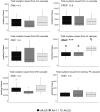Adverse effects of excessive dietary arachidonic acid on survival, PUFA-derived enzymatic and non-enzymatic oxylipins, stress response in rainbow trout fry
- PMID: 38811794
- PMCID: PMC11137042
- DOI: 10.1038/s41598-024-63173-x
Adverse effects of excessive dietary arachidonic acid on survival, PUFA-derived enzymatic and non-enzymatic oxylipins, stress response in rainbow trout fry
Abstract
Arachidonic acid (C20: 4n-6, AA) plays a fundamental role in fish physiology, influencing growth, survival and stress resistance. However, imbalances in dietary AA can have detrimental effects on fish health and performance. Optimal AA requirements for rainbow trout have not been established. This study aimed to elucidate the effects of varying dietary AA levels on survival, growth, long-chain polyunsaturated fatty acid (LC-PUFA) biosynthetic capacity, oxylipin profiles, lipid peroxidation, and stress resistance of rainbow trout fry. Over a period of eight weeks, 4000 female rainbow trout fry at the resorptive stage (0.12 g) from their first feeding were fed diets with varying levels of AA (0.6%, 1.1% or 2.5% of total fatty acids) while survival and growth metrics were closely monitored. The dietary trial was followed by an acute confinement stress test. Notably, while the fatty acid profiles of the fish reflected dietary intake, those fed an AA-0.6% diet showed increased expression of elongase5, highlighting their inherent ability to produce LC-PUFAs from C18 PUFAs and suggesting potential AA or docosapentaenoic acidn-6 (DPAn-6) biosynthesis. However, even with this biosynthetic capacity, the trout fed reduced dietary AA had higher mortality rates. The diet had no effect on final weight (3.38 g on average for the three diets). Conversely, increased dietary AA enhanced eicosanoid production from AA, suggesting potential inflammatory and oxidative consequences. This was further evidenced by an increase in non-enzymatic lipid oxidation metabolites, particularly in the AA-2.5% diet group, which had higher levels of phytoprostanes and isoprostanes, markers of cellular oxidative damage. Importantly, the AA-1.1% diet proved to be particularly beneficial for stress resilience. This was evidenced by higher post-stress turnover rates of serotonin and dopamine, neurotransmitters central to the fish's stress response. In conclusion, a dietary AA intake of 1.1% of total fatty acids appears to promote overall resilience in rainbow trout fry.
Keywords: Arachidonic acid; Confinement stress; Dopamine; Oxylipin; Serotonin; Trout.
© 2024. The Author(s).
Conflict of interest statement
The authors declare no competing interests.
Figures



Similar articles
-
Characterization and modulation of brain lipids content of rainbow trout fed with 100% plant based diet rich in omega-3 long chain polyunsaturated fatty acids DHA and EPA.Biochimie. 2020 Nov;178:137-147. doi: 10.1016/j.biochi.2020.06.010. Epub 2020 Jul 3. Biochimie. 2020. PMID: 32623048
-
Influence of the forms and levels of dietary selenium on antioxidant status and oxidative stress-related parameters in rainbow trout (Oncorhynchus mykiss) fry.Br J Nutr. 2015 Jun 28;113(12):1876-87. doi: 10.1017/S0007114515001300. Epub 2015 May 20. Br J Nutr. 2015. PMID: 25990817
-
Effects of dietary oxidized fish oil supplementation on oxidative stress and antioxidant defense system in juvenile rainbow trout (Oncorhynchus mykiss).Fish Shellfish Immunol. 2018 Mar;74:43-51. doi: 10.1016/j.fsi.2017.12.039. Epub 2017 Dec 27. Fish Shellfish Immunol. 2018. PMID: 29288811
-
Fatty acids, the immune response, and autoimmunity: a question of n-6 essentiality and the balance between n-6 and n-3.Lipids. 2003 Apr;38(4):323-41. doi: 10.1007/s11745-003-1067-z. Lipids. 2003. PMID: 12848277 Review.
-
Metabolites derived from radical oxidation of PUFA: NEO-PUFAs, promising molecules for health?Atherosclerosis. 2024 Nov;398:118600. doi: 10.1016/j.atherosclerosis.2024.118600. Epub 2024 Sep 15. Atherosclerosis. 2024. PMID: 39341752 Review.
Cited by
-
Metabolomic Profiling Reveals Social Hierarchy-Specific Metabolite Differences in Male Macrobrachium rosenbergii.Animals (Basel). 2025 Jun 29;15(13):1917. doi: 10.3390/ani15131917. Animals (Basel). 2025. PMID: 40646816 Free PMC article.
-
Mitigation of Dietary Microplastic Accumulation and Oxidative Stress Response in Rainbow Trout (Oncorhynchus mykiss) Fry Through Dietary Supplementation of a Natural Microencapsulated Antioxidant.Animals (Basel). 2025 Apr 1;15(7):1020. doi: 10.3390/ani15071020. Animals (Basel). 2025. PMID: 40218413 Free PMC article.
References
-
- Cottrell RS, Blanchard JL, Halpern BS, Metian M, Froehlich HE. Global adoption of novel aquaculture feeds could substantially reduce forage fish demand by 2030. Nat. Food. 2020;1(5):301–308. doi: 10.1038/s43016-020-0078-x. - DOI
-
- Lazzarotto V, Corraze G, Leprevost A, Quillet E, Dupont-Nivet M, Médale F. Three-year breeding cycle of rainbow trout (Oncorhynchus mykiss) fed a plant-based diet, totally free of marine resources: Consequences for reproduction, fatty acid composition and progeny survival. PLoS ONE. 2015;10(2):1–17. doi: 10.1371/journal.pone.0117609. - DOI - PMC - PubMed
-
- Panserat S, et al. Differential gene expression after total replacement of dietary fish meal and fish oil by plant products in rainbow trout (Oncorhynchus mykiss) liver. Aquaculture. 2009;294(1–2):123–131. doi: 10.1016/j.aquaculture.2009.05.013. - DOI
-
- Bell MV, Tocher DR. Biosynthesis of polyunsaturated fatty acids in aquatic ecosystems: General pathways and new directions. Lipid Aquat. Ecosyst. 2009;9780387893662:211–236. doi: 10.1007/978-0-387-89366-2_9. - DOI
-
- Tocher DR. Metabolism and functions of lipids and fatty acids in teleost fish. Rev. Fish. Sci. 2003;11(2):107–184. doi: 10.1080/713610925. - DOI
MeSH terms
Substances
LinkOut - more resources
Full Text Sources

